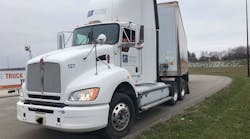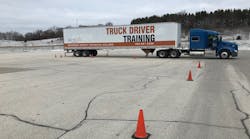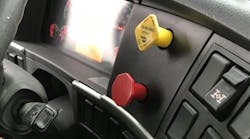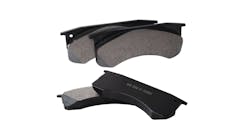Since starting Waukesha County Technical College's professional truck driving program, I’ve had a few friends and co-workers ask how it’s going. Most in the industry understand driving a big rig is nothing like driving a passenger vehicle on the road.
There are two big misconceptions I’ve run across when explaining some of the challenges for semi drivers: the reason for slower acceleration speeds, and the reasons tractor-trailers “are always trying to get into my lane when they’re turning.”
Both are simple concepts to understand, but can be harder to execute.
Weight comparison
First, the reason a truck gets going slower is the same reason it takes longer to slow down. While your paltry sedan might weigh in at 4,000 pounds fully loaded, a 61-foot fully-loaded tractor-trailer will weigh in around 80,000 pounds. Imagine the power and time it takes to get that much more weight moving. And, imagine how much more time it can take (12-15 seconds at 60 mph) to slow that vehicle down. This is also why you should leave a good distance between your tail end and the front end of that big rig when you’re driving.
Off-tracking and turns
Add to that the actual length comparison between both vehicles. A Toyota Camry, for example, will measure up at about 15'. A standard tractor-trailer will total more than 60'.
This also accounts for the crazy wide turning radius, and the reason “those trucks are always in my lane.”
We learn in this course that you’re not driving the tractor, you’re driving the trailer. And driving the trailer means you have to account for how it will off-track.
Imagine this: You’ve got two parts to the semi: the tractor, and the trailer. The tractor only accounts for about one-third of the length of the full vehicle. So, the pivot point, where the tractor and trailer connect (e.g. the fifth wheel and kingpin, coupled together) isn’t evenly distributed. So when a tractor is turning, it needs to exaggerate that turn further out, to ensure the trailer doesn’t cross over into oncoming traffic (for left turns) or run over a curb (for right turns).
In other words, you need to account for how the trailer will off-track. So when you see a tractor-trailer taking up two lanes at a roundabout, or at a turn signal,it’s because that lady or gentleman is accounting for how she or he is driving the trailer. The last thing we want to do is run over a curb, or worse, your vehicle.
This isn't to say many of the other passenger vehicle drivers (and, other semi drivers for that matter) haven't been respectful and assist with backing up at a light or politely waving when students like me are behind the wheel making these turns. But, there are plenty of others who don't. Next time you come across a big rig, keep their unique circumstances in mind.
Before enrolling in this program, I acknowledged tractor-trailers needed to operate a bit differently on the road. But now, more thoroughly understanding the process, I have a newfound respect for it.
...
In the Driver’s Seat is a blog series from Fleet Maintenance editor-in-chief Erica Schueller. The series covers the process of attending a formalized technical training professional truck driving program in order to obtain a Class commercial vehicle driver’s license.







